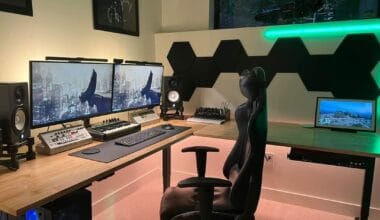Do you ever feel bored looking at your dull and uninteresting home office space?
If you are thinking about adding an accent wall, let us tell you that you are about to make a perfect choice.
Adding an accent wall in the home office is excellent for solidifying a theme and defining your personal space while experimenting with the existing decor to create something new and exciting.
However, do not just play around with colors when adding an accent wall. Look to enhance the functionality of the space as well when defining the area.
If you are wondering how to create an accent wall for your home office, here we have the rules, the Dos and Don’ts, and tips about getting accent walls right!
Table of Contents Show
What is an Accent Wall?
An accent wall accentuates one of the walls in the room to make it look different from the rest.
It is called an accent wall because a single space is emphasized in color, décor, and functionality from the rest of the walls.
Also known as a “feature wall” or “focal wall,” an accent wall becomes the room’s highlight because of the pop of color, theme, or unique decor.
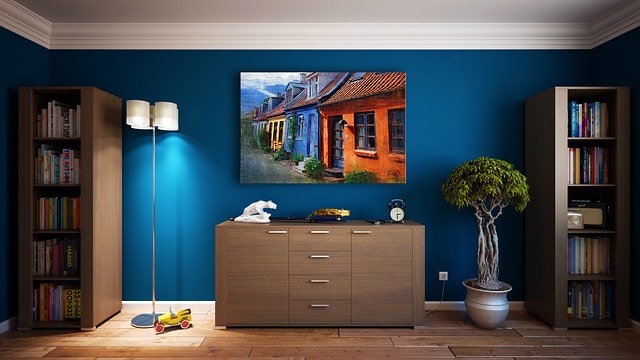
Here is a thing. You can only pick one accent wall. If you choose more than one, it wouldn’t have the same effect.
However, there is no limit to what you can do with your accent wall and which room to pick. You can use your bedroom, kitchen, hall, or even home office!
An article about The Science of Office Design points out a scientific link between interior design and productivity. Our environment has a significant effect on our mental state.
However, aesthetics is not the sole purpose of an accent wall.
You can use it to define a more critical space than the rest, such as the home office station, a wall of fame and awards, or a wall with paintings, art, and sculptures.
A nicely done accent wall should perform two functions –décor and definition of space.
What about Adding an Accent Wall in your Home Office?
A home office is where you spend a significant amount of days. Therefore, spicing up the space may help to brighten your mood and amplify productivity.
If you think adding an accent wall in a home office is overdoing it, let us tell you that it can be a great idea to turn your dull-looking home office into something interesting.

Dr. Craig Knight, who studied the psychology of workspace for over 12 years, suggests that if you enrich an office space, people feel much happier and work better.
Therefore, an accent wall may elevate your overall work experience, satisfaction, well-being, and productivity by eliciting positive emotions.
Before deciding anything further, let us look at the pros and cons of adding an accent wall in the home office.
Pros of Having an Accent Wall in your Home Office
Here is the list of advantages of adding an accent wall in the home office.
1. Highlight Interesting Features
- The accent wall works best when highlighting the pre-existing architectural features on your wall.
- The exciting features may include windows, a fireplace, asymmetrical wall space, or other excellent details.
- By focusing on a particular wall with a unique color shade, task lighting, or decorations, you can bring more attention to it to highlight your home office.
2. Defines Space by Adding Layer
- When a wall is colored or designed slightly differently from the rest, it tends to pop out, especially when setting up a home office.
- Coloring it differently and adding a task light will help add a layer to the wall to create depth while the rest of the room remains neutral in terms of lighting and color.
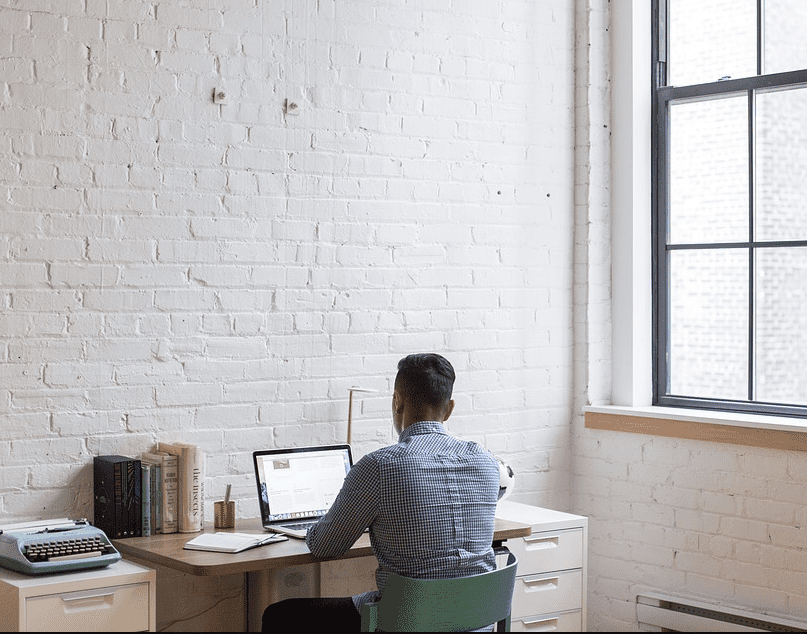
3. Personalizes Your Space
- Adding a bolder color without overwhelming the room may help define your space to make you feel at home.
- Some prefer using neutral colors on the wall, while others may choose bold colors. When you have one wall dedicated to your preferred color, you tend to lean towards it.
- It may be helpful to define your personal space when you are sharing the home office with co-workers.
4. Makes Small Room Seem Larger
- Adding an accent wall helps with optical illusion to make your small room look bigger.
- Changing the color of one wall with a darker, lighter, or more dramatic tone may add depth to the space.
- It makes you believe that the room feels more significant than it works well when you have a tiny home office.
Cons of Having an Accent Wall in your Home Office
While focal walls can be a great addition to your home office, they may seem distracting if not done correctly.
Here are a few more disadvantages of adding an accent wall.
1. They Look Outdated
- Adding accent walls was in style almost two decades ago, which makes them a pretty outdated style.
- Today, most workplaces keep office walls similar in color and style to help bring uniformity.
- It may help you stay focused on your screen by avoiding distractions.
2. Make the Space Look Busy
- When you choose bold colors for your accent wall and add decorations, you make it look busy.
- It may worsen the situation when your small home office furniture is already bold and cluttered.
- A home office should be spacious and minimal to avoid busyness; thus, adding an accent wall may prove detrimental.
3. Chops Up a Wall
- The idea for an accent wall is to complement the space while remaining cohesive with its surroundings.
- When you choose the wrong shade for an accent wall or overdo it by adding more art, wallpaper, or lighting, you make it look separated from the rest of the space.
- It may create an unbalanced style that will be overwhelming when working.
4. They Create a Distraction
- An accent wall will create a distraction when you are not used to seeing it, creating randomness.
- When creating a focal wall space, you must choose the right color and décor that complements the home office space.
- However, if you highlight ‘nothing,’ will create a visual distraction that will constantly take your mind away from work.
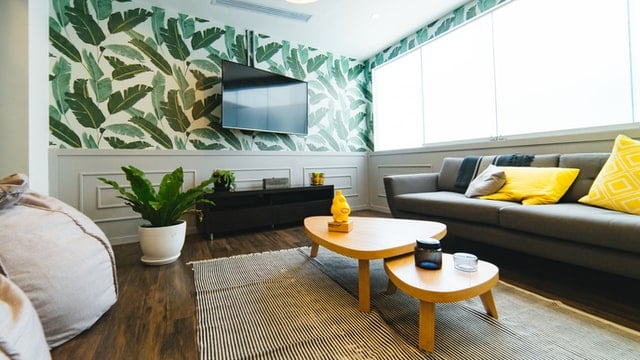
How to Choose the Accent Wall for your Home Office?
Choosing an accent wall can be tricky when all the walls in a room look alike.
Pick the room’s focal wall, such as a wall with a fireplace traditionally. Otherwise, create your focal wall by highlighting the space.
When choosing an accent wall for a home office, you should often create your focal wall.
Note: The accent wall is best described by the theme you want to create so that it can be any wall in the room, but ensure to work around the natural lighting, so you do not offset the focal wall.
Working around the natural lighting will ensure your accent wall is illuminated.
Here are some Dos and Don’t for choosing the right accent wall.
Some Do’s While Choosing an Accent Wall
- The focal wall should be the one you will be facing when seated.
- Choose the first wall you see when entering the room as an accent wall, leaving whoever walks into your home office impressed.
- Choose a wall with ample natural or ambient lighting and enough space to add decor such as colors, art, drawers, or layering materials like wooded accents.
- Make use of misaligned wall space that may look odd compared to other walls in the room. It will save up space and enhance an otherwise crooked space.
Some Dont’s While Choosing an Accent Wall
- Do not sit with your back facing the focal wall. It may only work when you place your workspace beside the accent wall.
- Do not forget to use the ceiling space. Also known as the fifth wall, you can use the ceiling to add additional colors and fixtures to make it pop out.
- Do not make your accent wall busier by overdoing the decorations.
- Do not just use any wall in a room because each accent wall serves a different purpose. For example, a home office should strictly create a productive area.
Should Accent Wall Color be Lighter or Darker?
Coloring the accent wall slightly or altogether different from the rest will automatically highlight it.
Home office walls should naturally be neutral in color to prevent distractions.
However, be careful about choosing dark shades that may give a feeling of a crowded or small space.
Choose lighter shades when converting an otherwise dark space into an accent wall. Pick ambient lighting to illuminate the entire wall, or stick with task lighting focused on the workstation.
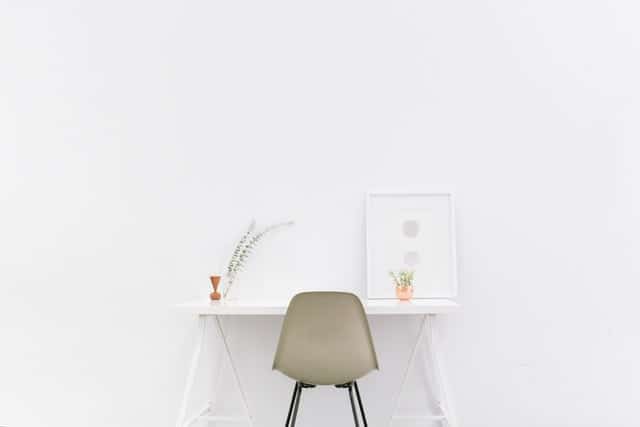
According to an interior design blog, too much colorfulness might spoil the plan, too, making the colors force sensory overload and appear overbearing.
To avoid making your accent wall either too lighter or darker, play around with the colors of the items in your room.
When your furniture, sofa, or drawers are dark-colored, you can choose lighter accent walls to create contrast.
Similarly, when the items are neutral in shade, you should go with the bold and darker accent wall color.
According to an answer on Askinglot.com, “A darker hue will contrast with the lighter walls and pull eyes straight to it.”
Using neutral shades for the accent wall will help to create balance in an otherwise clumsy room.
Note: Ensure that the neutral shade is a few shades lighter or darker than the color on the rest of the room’s walls to maintain a balanced contrast.
Choosing the Right Color for the Accent Wall
Colors give a personality to your home office, so the question is how well you can achieve it.
There is no fast rule for choosing the right accent wall color, but ensure to choose colors that add character and depth to the room.
Hence, to avoid overdoing it, follow the simple 60-30-10 rule.
| Color | Specification |
|---|---|
| 60 | 60% of your room will have the same color, primarily neutral tones like beige, cream, pastel, white, or aqua blue. |
| 30 | 30% of the shade should create a contrast to otherwise dominating wall colors. It would come from upholstery, drawers, and decorations. |
| 10 | 10% of the color should create visual interest, such as accent color. |
Here are some factors to consider while choosing the right accent color.
1. Create a Mood
Different colors convey different feelings, so choose one that suits your office’s mood.
Bold colors like royal blue and fire-station red may spice up the accent wall to make it overtly dominating and distracting.
In contrast, muted colors like white or beige may give a dull feeling.
Therefore, cool tones like aqua blue, yellow, and light green will keep you refreshed while avoiding distractions.

Warm colors like red and orange may look attractive but give a feeling of restlessness and rush.
2. Find a Purpose
Not every room in a house will have the same accent color.
A living room will have a more vibrant accent color than the bedroom because you indulge in various physical activities in a living room.
For a home office, the accent wall should keep you active, focused, and energized at all times.
Therefore, make a balance between warm and cool color tones. For example, if the room walls are cool (shades of lighter blue or green, white, beige, or gray), choose a warm color for the accent wall and vice versa.
Popular colors for warm colors are orange, royal blue, army green, yellow, and red.
Using cooler tones help to make the room look bigger, while adding a splash of warm color may make a wall feel pop out.
For a room painted in bold color, choose a lighter shade for an accent wall to make it look bigger than the rest.
3. Use Darker Tones
Along with creating a contrast, the accent color will complement the rest of the wall by using the same color but in a different shade.
As a rule of thumb, you should paint the accent wall the same color as the rest but two or three shades darker.
If your room walls are darker in shade and you end up using the lighter shade on the accent wall, it may become disorienting.
As a solution, you can use decorations such as drawers, houseplants, and painting in front of the accent wall to balance it out.
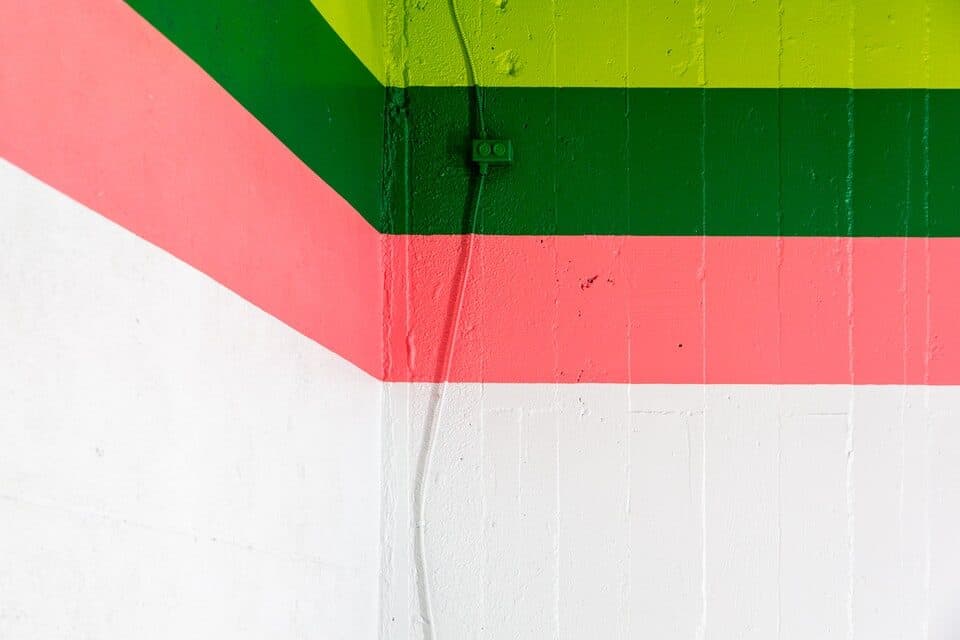
4. Complement the Space
Overall, the accent wall color should complement the entire space, including the rest of the walls, curtains, and upholstery.
Your accent wall color must work with your existing décor, and the best way to do this is by replicating the colors.
However, instead of replicating the most used color in the room (walls and furniture), choose a secondary color from the cushion, pillow, houseplant, etc.
Take reference from the most minor used colors to turn it into a pop color for the accent wall.
Learn more about choosing the Right Wall Color for Your Home Office
Best Color Choices for Accent Wall
Here is a table describing the most preferred accent colors suitable for your home office.
| Color | Specification |
|---|---|
| Lemon Yellow | A vibrant choice of color for an accent wall that radiates warmth |
| Charcoal Gray | A neutral choice of accent color that complements minimally decorated home office. |
| Peach | A usual shade for an accent wall, it will mimic the rosy glow of spring flowers. |
| Kelly Green | A dominant choice of color that offers warmth and fullness. |
| Navy Blue | It is a popular choice for indoor color that gives out a pop of flavor. |
| Lilac or Soft Purple | Lilac gives the warmth of purple but also offsets its warming tone with some coolness. |
| Crisp White | It may work well when the rest of the wall is colored in a muted tone, such as beige or light gray. |
| Mint Green | It gives a herb-like color that will keep you fresh and rejuvenated. |
| Coral | Coral is pink with a bright shade that will give a warmer tone. |
| Royal Blue | It is another popular accent color choice because the wall will pop out in style, giving a feeling of holidaying. |
Are Accent Walls Still in Style?
It would depend on using an accent wall in the home office or the rest of the house.
According to an article about interior design trends for 2021, accent walls likely would not be as trendy in 2021 as before.
Interior Designer, Dennese Guadeloupe Rojas, points out that the age of accent walls in the home is drawing to a close, and people are switching to monochromatic walls instead.
However, it does not mean you cannot use one for your home office because adding an accent wall is your choice.
Choose modern accent walls like texture instead of plain old colors to keep your home office up to date.
Using wallpaper with different designs and textures or laminated woods (layers of wallboard) may give your home office a modern accent wall.
Best Accent Wall Design Ideas for your Home Office in 2024
Here are handfuls of accent wall ideas to spice up your rather dull-looking home office.
1. Keep your Accent Wall Clean and Bright
Clean and bright décor never goes out of style. The bright and light-colored accent wall will help you focus while avoiding distractions.
Keeping your furniture and drawers in a lighter tone will help complement the accent wall.
2. Work Around the Existing Structures
If your home office already has an architectural element such as a fireplace, built-in bookcase, or stonework, consider working around these elements to create a unique accent wall.
Using these elements helps to draw attention to an existing focal point without doing much.
When turning it into an accent wall, ensure to use paint color and lighting that complements the existing architecture.
3. Feature Accent Wall with Snaps
Use your accent wall to display a photo collage to share and relive your cherished moments.
Start with picking the right-sized frames that complement each other. Next, arrange for them to create a collage.
About choosing the photos, you can pick your childhood memories, graduation, marriage, engagement, or any other special moment you want to share.
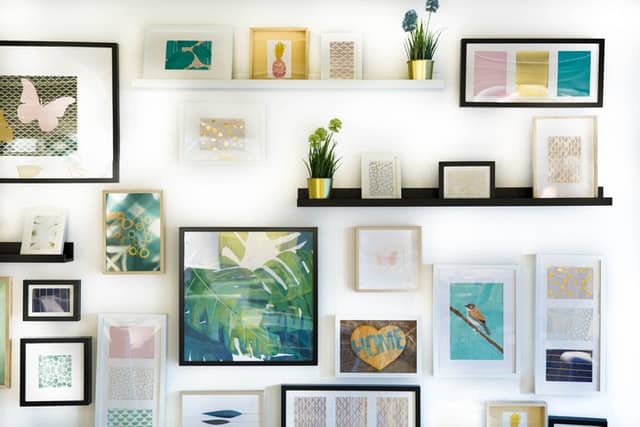
4. Redo the Wall With Stonework and Drawers
Create a stunning stone accent wall that will highlight your home office.
To complement the stonework, consider adding overhanging drawers or shelves to hold ornamental houseplants, small decorations, books, and much more.
The stonework offers a natural, rustic touch to the wall without adding any paint and helps to keep you’re space cool.
5. Give a Modern Touch
Adding a large piece of artwork, image canvases, art murals such as forests and cityscapes, or quotes to the accent wall.
These easy and inexpensive décor choices will spice up your home office’s accent wall.
Moreover, you will have thousands of options to choose from.
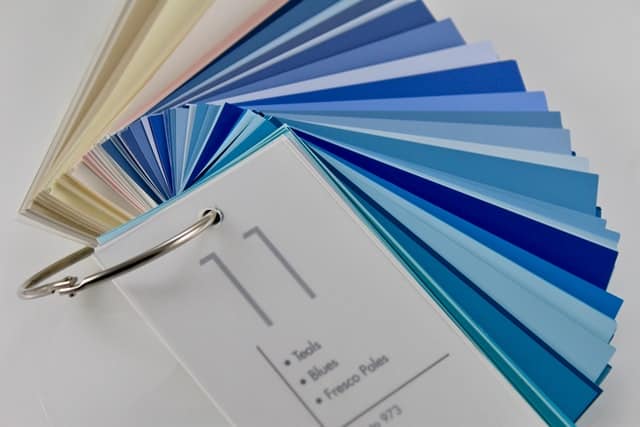
6. Use Stencil to Add Color and Patterns
Wall stencil patterns are a fantastic alternative to conventional latex paint.
Instead of repainting the overall wall, you can use stencil sketches to create hundreds of patterns.
The newest wall stencils are easy to use and may take less time to complete.
It may be a great way to accentuate a wall without overwhelming it, and you need not do much to create a dramatic-looking accent wall.
7. Add a Wood Accent Wall
Adding wood planks give a warm, rich texture to an otherwise dull space.
When using wood accent walls, you can complement them with wood crates, wood picture frames, and wood furniture.
Depending on your budget, you can choose from expensive parquet materials or inexpensive shiplap wood.

Rustic wall paneling is another inexpensive choice for wooded accent walls. You can add one for as low as $3.09/sq. ft
Here is how you can create a wooded accent wall.
8. Use Brick Wall Texture
Decorating an accent wall with brick is a good idea to make it pop out.
It is also great for creating a bespoke wall graphic for an otherwise dull-looking room.
If adding bricks is not an option, you can choose printed brickwork vinyl that works just like wallpaper.
The advantage of choosing a brick wall layer is that you can choose from many different styles and textures.
9. Use Wallpaper for Accent Wall
Although it may seem quite outdated, wallpaper is still a popular choice to create an accent wall. They are simple yet highly effective.
- Choose heritage prints to give the vintage House a feeling, or go with monochrome to make your room modern.
- Bright and bold wallpaper colors complement the relatively light-colored space.
- Use floral wallpaper to give a feeling of greenery in your room.

10. Go with a Conventional Color Combination
If nothing seems to work, go with the conventional color combination style.
Set the tone of your workroom by combining two colors: blue and sandstone, green and red, or blue and cream.
Using three colors may be a risky choice, but you can give it a try by choosing less-risky colors.
For example, go for black, green, and cloudy gray; black, white, pebble gray, or dark clay with pastel blue and pink.
FAQs About Accent Walls
Should an Accent Wall have a Window?
Indeed, an accent wall can have windows too.
A wall that has impressive windows will offer an architectural feature that can benefit an accent wall.
However, be wary about using dark accent colors around the windows to create a good light effect.
Read more on the pros and cons of facing the window when working.
Should I Paint One or More than One Accent Wall?
The focal wall will lose importance when you make more than one accent wall in a room.
An accent wall is intended to create a highlighted wall space different from the rest.
When you highlight two different walls, you may create a confusing environment. Therefore, stick with one accent wall in a room.
Do Accent Walls Make Rooms Look Too Small?
Accent walls painted in dark shades will make your room feel smaller because darker shades reflect less or no light.
Stick to light colors or neutral tones when creating an accent wall, as it will reflect more light in the room.

Final Verdict
When creating an accent wall in the home office, think beyond aesthetics —Choose an accent wall that is both good-looking and productive.
Dedicated wall space will help set your workspace aside from other parts of the room and help you keep focused on work.
Start with deciding which wall should be your accent wall. Next, decide on the theme, followed by choices of colors and decorations.
Keep this in mind. Your accent wall should define a unique space while complementing the rest of the walls.
Related Article: How do Mirrors Elevate Your Home Office?

